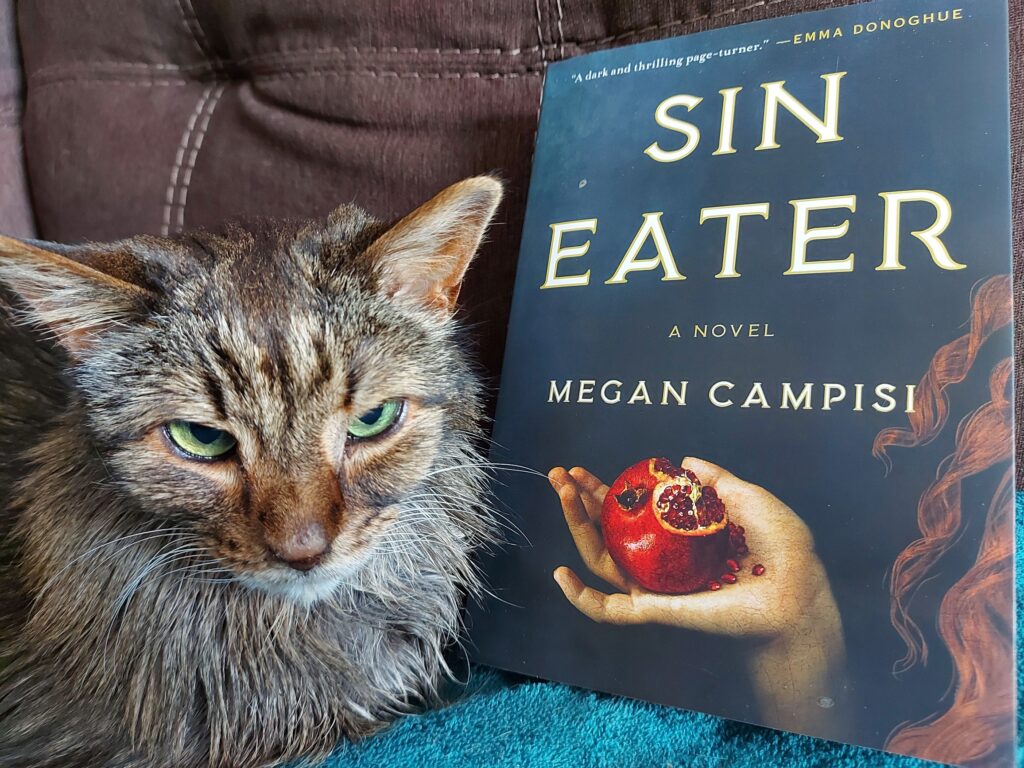Sin Eater by Megan Campisi

Has anyone heard of sin-eating? I had no idea sin-eaters were an actual thing until I read Sin Eater by Megan Campisi. Of course, I had a go down the Google rabbit hole after I finished reading this novel to learn more about sin-eaters. It was an actual custom practiced in many countries, more particularly in Scotland, Wales and England, were a person, the sin-eater, would consume a ritual meal in order to take on the sins of a deceased person. The last known sin-eater apparently died in 1906. It is interesting the things that people believe in, and it is also interesting that anyone with such beliefs would willingly take on the role of sin-eater.
If you like historical fiction and mysteries, then this novel is for you. It is about a 14-year-old orphaned girl, May Owens, who is arrested for stealing bread and sentenced to become a sin-eater. The novel is set in 16th century England; however, it is an alternate history of England. Queen Elizabeth I is Queen Bethany in this novel; her father is King Harold II, not King Henry VIII. You’ll probably recognize other historical figures given different names in this book. God is called Maker and churches are called Makerhalls. I’m not sure what the point is of creating an alternate history; I think this novel would have felt more authentic as historical fiction if Campisi had just stuck to actual history (but maybe she didn’t want anyone to be offended by her portrayal of Queen Elizabeth I?).
As a sin-eater, May is outcast from society. No one is supposed to speak to her or even look at her. May herself is not supposed to speak anymore. Forced to give up her home, she ends up living with the other sin-eater in town who teaches her the ropes of sin-eating. Campisi included a neat little compendium of sins and what their equivalent foods are. When someone is dying, May is to go to that person’s house for the “recitation”, the only time May is allowed to speak, when the dying person recites their sins. May then gives the list of corresponding foods to their loved ones to prepare. After the person dies, May goes back to eat the food off their coffin, thereby taking on that person’s sins.
The mystery kicks in when May and the other sin-eater go to a recitation for one of the Queen’s ladies, a royal governess. The governess recites her sins, alluding to some mystery involving the Queen, and the other sin-eater gives the list of foods. When May and the other sin-eater go back for the “eating”, there is a deer heart on the coffin, which wasn’t included in the list of foods for the governess’s sins. But what does the deer heart mean?? May doesn’t know, and we don’t know either because it isn’t included in the compendium. The other sin-eater refuses to eat the deer heart, so it must be bad, and so she is tortured to death. May does eat the deer heart to save her own skin, but her life ends up in danger anyways.
But this novel is also an examination of how religion, and society, treats women. Sin-eaters are always women. Why? Because Eve was guilty of the first sin when she ate the forbidden fruit. Eve is treated like a bogeyman and a devil in this novel. If the sin-eater doesn’t consume your sins, then you’re going to hell to spend eternity with Eve. The recorder who sentenced May to be a sin-eater uses this punishment as a way to silence women (I won’t spoil why he gave this sentence to May or the other sin-eater).
May is a plucky heroine, despite being sentenced to such a cruel punishment. She’s illiterate, she doesn’t have much knowledge about the world, or even her own life, but she is quick-witted and determined enough to get the bottom of the mystery of the deer heart and avenge the other sin-eater’s death. I found this novel interesting, but when I finished it, I found myself feeling… unsatisfied. I think it’s because even though May figures out the central mystery of the novel about what the deer heart represents, if not exactly how it ends up on not just one, but two coffins, she doesn’t get all the answers she is looking for, and so the novel ends with some conjecture on her part. This novel doesn’t wrap things up with a tidy bow. I know it’s more authentic to real life to not have every single question answered, but I still can’t help feeling a little unsatisfied. In any event, it’s a strong debut from Campisi and I am interested in seeing what her next novel is like.